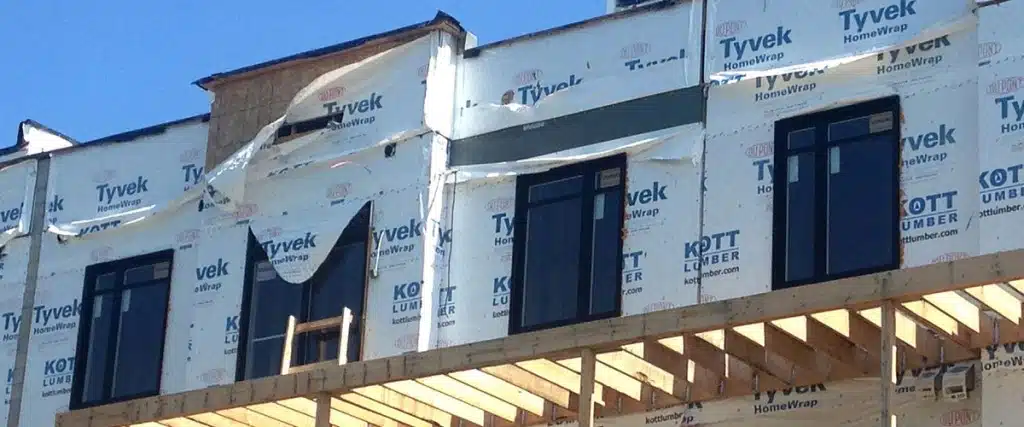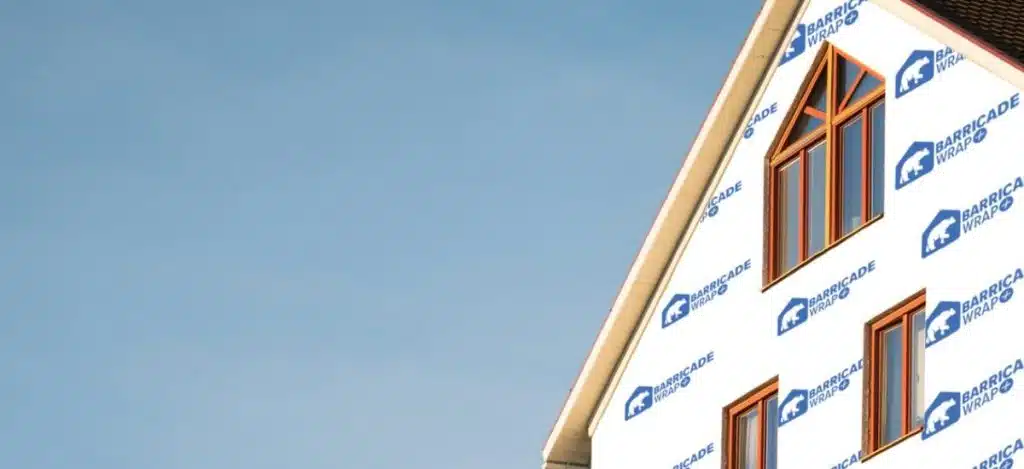A comparison of Typar® Building Wrap and Tyvek® HomeWrap® for residential construction found several common features; both meet the minimum requirements for water- and air-resistance and are cold resistant. However, they fall short on several elements of a high-quality weather-resistant barrier for home construction.
Barricade® Wrap Plus is a superior option for meeting and exceeding all the parameters of a high-quality weather-resistant barrier for home construction. Barricade® Wrap Plus is water and air resistant, cold resistant, and includes drainage against bulk water (unlike Typar®). Barricade® Wrap Plus is also surfactant-resistant (unlike Tyvek®), optimally vapor permeable (unlike Tyvek®) and has a longer UV rating than either Typar® or Tyvek HomeWrap®.
How to Compare House Wraps for Home Construction?
House wraps are weather-resistant barriers (WRBs) that function to stop air and moisture infiltration to the wall system of homes while protecting the sheathing. To accomplish these functions, a WRB needs to provide the right balance of water and air resistance and vapor permeability. They must also have the strength to resist damage during and after construction.
There are several necessary performance criteria to consider when comparing house wraps for home construction. These parameters include water and air resistance, vapor permeability, drainage, and durability.
The Water Resistance of House Wraps
An essential requirement of a house or building wrap is to keep water out of the wall system. The ICC-ES allows for three different water-resistance testing standards; however, only the first two are acceptable for plastic wraps.
- Water Ponding is a measure of a house wrap’s resistance to a “pond” of 1-inch water over two hours. CCMC 07102 (Section 6.4.5): Water-Ponding Test.
- Hydrostatic Pressure, the most stringent test, exerts significant pressures on a house wrap sample through a column of water (55 cm or higher). AATCC Test Method 127: Water Resistance Hydrostatic Pressure Test.
- The Boat Test for paper and felt wraps is the least stringent standard. Because it is overly sensitive to vapor and humidity transfer, it is unreliable for plastic house wraps. ASTM D779: Standard Test Method for Water-Resistance of Paper, Paperboard, and Other Sheet Materials by the Dry Indicator Method.
The Air Resistance of House Wraps
The air resistance of house wraps is a continuous system that prevents movement of air across the building envelope. Several tests measure air resistance.
- ASTM E2178: Standard Test Method for Air Permeability of Building Materials (cfm/ft2 @1.57 psf)
- Gurley Hill (TAPPI T-460) (sec/100cc)
- ASTM E1677
The Vapor Permeability of House Wraps
Vapor permeability (perms) is the amount of vapor transmission that a house wrap allows over time. The ASTM E96: Test Method for Water Vapor Transmission of Materials determines perms. The greater the perm, the more vapor permeable the wrap. However, it can’t be so high that water can penetrate from the outside into the wall assembly.
According to Joseph Lstiburek, of the Building Science Corporation, the perfect WRB perm, for balancing the outward and inward movement of moisture in a wall assembly is between 10 and 20 perms.
Comparing Drainage of House Wraps
Drainage is an effective way to reduce moisture infiltration to the wall system due to rain. A high-quality house wrap should be designed to provide an integrated gap and a drainage plane so to resist bulk water.
The Durability of House Wraps
A durable house wrap can withstand the handling and installing process without becoming damaged, which will compromise its water-resistance performance. Durability parameters include tensile strength, ultraviolet (UV), cold, and surfactant resistance.
- ASTM D1117 determines tensile strength or tear resistance.
- UV rating is how long a wrap will maintain its integrity when exposed to sunrays.
- Cold resistance test standard (AC38 Section 3.3.4: Cold Mandrel Bend Test) ensures the wrap will not crack at low temperatures
- Surfactant resistance is vital to the long-term durability of a house or building wrap. Surfactants are contaminants, like soap and oils, which lessen the surface tension of a liquid preventing it from penetrating deeper into the house wrap material.
Comparing Tyvek® HomeWrap® and Typar® House Wrap for Home Construction
Tyvek® HomeWrap®
Olefin sheets that are non-woven and non-perforated comprise the DuPont™ Tyvek® HomeWrap®. High-density polyethylene(HDPE) fibers that are flash spun-bonded using heat and pressure form the uniform web that makes up the sheets. The webs create microscopic pores that resist bulk water and air infiltration while allowing moisture that enters the wall system to evaporate.
- Tyvek® HomeWrap® passes the AATCC Test Method 127 for water resistance at 250 cm.
- Tyvek® HomeWrap® pass the Air Resistance Gurley Hill (TAPPI T-460) at > 2500 sec/100cc.
- Tyvek® HomeWrap® has a permeability rating of 56
- Tyvek® HomeWrap® has a drainage plane
- Tyvek® HomeWrap® is cold resistant (AC38 Section 3.3.4)
- Tyvek® HomeWrap® is not surfactant resistant
- Tyvek® HomeWrap® has a Trapezoid Tear Strength (ASTM D1117) of 30/33 lbs
- Tyvek® HomeWrap® has a UV rating of 4 months.
Typar® Building Wrap
Typar® Building Wraps are a polypropylene nonwoven breathable weather membrane. A thin film coating on a polypropylene fiber mesh makes up the Typar® Building Wrap. The polypropylene fiber mesh provides tear resistance and supports the thin film layer, which provides the water and air resistance.
- Typar® Building Wrap passes the AATCC Test Method 127 for water resistance at 865 cm.
- Typar® Building Wrap passes the Air Resistance Gurley Hill (TAPPI T-460) at > 2500 sec/100cc.
- Typar® Building Wrap has a permeability rating of 7
- Typar® Building Wrap does not have a drainage plane
- Typar® Building Wrap is cold resistant
- Typar® Building Wrap is surfactant resistant
- Typar® Building Wrap has a Trapezoid Tear Strength (ASTM D1117) of 30/33 lbs
- Typar® Building Wrap has a UV rating of 6 months
Typar® House Wrap vs. Tyvek® HomeWrap®
A comparison of Typar® House Wrap and Tyvek® HomeWrap® shows they have several attributes in common: both achieve the minimum requirement for water and air resistance and are cold resistant. However, each product has advantages over the other product.
Advantages of Tyvek® HomeWrap® Over Typar® Building Wrap
- Tyvek® HomeWrap® is 4 to 20 times thicker than Typar® Building Wrap. The added thickness adds durability against rough handling or heavy winds.
- Tyvek® HomeWrap® provides full-thickness protection against air and water intrusion. Typar® Building Wrap only provides a single layer.
- Typar®’s thin layer is not consistent and varies from 4.8 to 22.6 microns, which compromises Typar®’s durability. The thinnest areas are more susceptible to tearing, abrasions, or separation from the fiber mesh during and after installation Once damaged, the thin film is no longer air and moisture resistant.
- Typar® Building Wraps has a lower perm rating compared to Tyvek® HomeWrap®; so, a wall covered with Typar® can take longer to dry, which increases the risk of mold, mildew, and rot.
- Tyvek® HomeWrap® has a drainage plane so can manage bulk water better than Typar® Building Wrap, that does not have a drainage plane.
Advantages of Typar® House Wrap over Tyvek® HomeWrap®
- Typar® building wrap’s UV rating is two months longer than Tyvek®, which is an advantage of Typar® if a project is delayed and the wrap is left exposed to the sun.
- Typar® is surfactant resistant. Tyvek® is not surfactant resistant.
- Typar® building wrap’s perm falls in the recommend ratings for balancing the outward and inward movement of moisture in a wall assembly (10-20). Tyvek® HomeWrap® perm rating is higher (56) than the recommended rating.
- Typar® building wraps have nearly four times the tear strength (ASTM D1117) as Tyvek® HomeWrap®.
Why Barricade® Wrap Plus is a Better Choice Over Typar® Building Wrap and Tyvek® HomeWrap® for Home Construction
Barricade® Wrap Plus is a non-perforated, non-woven polyolefin material with a permeable membrane. Barricade® Wrap Plus’ micro-porous and breathable membrane controls moisture and air infiltration, yet its permeability allows evaporation of moisture vapor, should it make its way inside the wall system. Barricade® Wrap Plus’ film resists rain (bulk water penetration) and when installed properly acts as an effective drainage plane.
Barricade® Wrap Plus is a weather-resistant barrier for home construction that has all benefits and none of the disadvantages of either Typar® Building Wrap or Tyvek® HomeWrap®.
Like Typar® and Tyvek®, Barricade® Wrap Plus achieves the minimum requirement for water and air resistance and is cold resistant. However, there are several attributes of Barricade® Wrap Plus that make it the better choice in a house wrap over Typar® and Tyvek®.
- Barricade® Wrap Plus UV rating of 9 months is greater than either Typar® (6 months) and Tyvek® (4 months). The greater UV rating gives Barricade® Wrap Plus greater durability when exposed to the suns’ rays than Typar® and Tyvek®.
- Barricade® Wrap Plus has a Perm of 16, which is in the permeability range that ensures an outward and inward balance of movement of moisture in a wall assembly. Tyvek® is much higher. Typar® is lower than Barricade® Wrap Plus, so not as optimally permeable as Barricade® Wrap Plus.
- Barricade® Wrap Plus has a drainage plane. Typar® does not have a drainage plane.
- Barricade® Wrap Plus is surfactant-resistant. Tyvek® is not surfactant-resistant.
A comparison of Typar® Building Wrap and Tyvek® HomeWrap® for residential construction found that they both fall short on several elements of a high-quality weather-resistant barrier. A better option for meeting and exceeding all the parameters of a high-quality weather-resistant barrier for home construction is the Barricade® Wrap Plus.
Barricade® Wrap Plus exceeds all the requirements of a WRB for home construction. It is water and air resistant, vapor permeable, highly durable and includes bulk water drainage.


